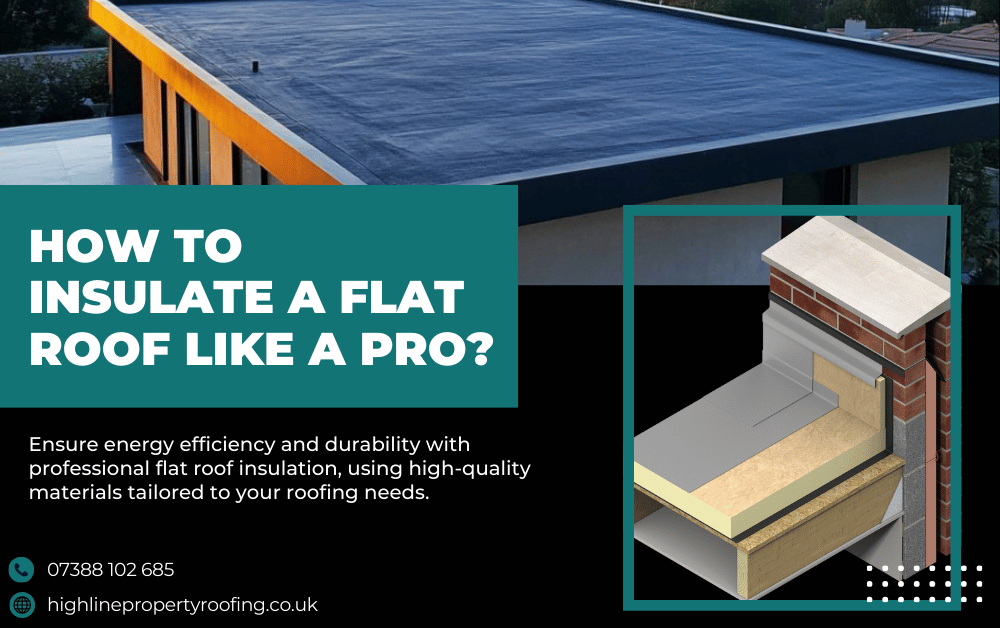Warning: Undefined array key "style" in /home/u595483593/domains/highlinepropertyroofing.co.uk/public_html/wp-content/themes/pearl/partials/header/elements/menu/menu.php on line 79
Warning: Undefined array key "style" in /home/u595483593/domains/highlinepropertyroofing.co.uk/public_html/wp-content/themes/pearl/partials/header/elements/menu/menu.php on line 90
How to Insulate a Flat Roof Like a Pro

Proper insulation for flat roofs is crucial for maintaining energy efficiency, reducing heating costs, and extending the lifespan of your roof. With the right techniques and materials, you can ensure your flat roofing remains effective in protecting your home from the elements while keeping it comfortable year-round. This guide covers everything you need to know about how to insulate a flat roof, whether you’re a DIY enthusiast or seeking professional help.
Why Insulating a Flat Roof is Essential for Comfort and Efficiency
Flat roofs are a popular choice for modern homes and commercial properties due to their sleek design and cost-effectiveness. However, without proper flat roof insulation, they can become a source of heat loss and energy inefficiency. Insulating flat roofs properly not only improves indoor comfort but also saves money on utility bills. Let’s explore the best methods and materials for insulating a flat roof like a pro.
Why Insulating a Flat Roof is Important
- Energy Efficiency: Flat roofs, by design, can transfer heat more quickly than pitched roofs. Without insulation, heat escapes during the winter and enters during the summer, leading to higher energy bills.
- Preventing Moisture Issues: Proper insulation prevents condensation buildup inside the roof structure, which can lead to dampness, mold, and structural damage.
- Enhancing Durability: Insulation acts as an additional layer of protection for your flat roofing, reducing wear and tear caused by temperature fluctuations.
Methods of Insulating a Flat Roof
There are two primary approaches to insulating flat roofs, depending on whether the roof is new or existing.
Warm Flat Roof Insulation
In this method, insulation is installed above the roof deck but beneath the waterproof membrane.
- Benefits: Eliminates cold spots, prevents condensation, improves energy efficiency.
- Best For: New constructions or when replacing the roof covering.
Cold Flat Roof Insulation
In this approach, insulation is installed below the roof deck.
- Benefits: Cost-effective, retains existing roof covering.
- Challenges: Requires sufficient ventilation to prevent condensation buildup.
- Best For: Retrofitting existing flat roofs with limited budgets.
Step-by-Step Guide: How to Insulate a Flat Roof
Step 1: Assess Your Roof
- Inspect your flat roofing to determine its condition and identify areas that need insulation.
- Ensure the roof is clean and free of debris.
Step 2: Choose the Right Insulation Material
- Select insulation that meets your thermal performance needs and fits your budget.
Step 3: Install the Insulation
For Warm Flat Roofs:
- Lay a vapor control layer to prevent moisture buildup.
- Secure rigid insulation boards over the roof deck.
- Install a waterproof membrane on top.
For Cold Flat Roofs:
- Fit insulation between the joists underneath the roof deck.
- Leave adequate ventilation space to avoid condensation.
Step 4: Seal and Inspect
- Seal all joints and edges to ensure a tight fit.
- Inspect the finished roof for gaps or imperfections.
Common Mistakes to Avoid When Insulating Flat Roofs
- Skipping Ventilation in Cold Flat Roofs: Lack of ventilation can lead to condensation and damage.
- Using Low-Quality Materials: Poor insulation reduces efficiency and durability.
- Ignoring Roof Repairs Before Insulation: Any damage to the flat roof should be fixed before insulation begins.
Benefits of Proper Flat Roof Insulation
- Lower Energy Costs: Reduces heat loss and saves on heating bills.
- Increased Comfort: Maintains a consistent indoor temperature.
- Longevity: Protects the roof structure from moisture and thermal stress.
- Environmental Impact: Decreases your home’s carbon footprint by improving energy efficiency.
Conclusion
Proper flat roof insulation is a game-changer for your home or commercial property. Whether you opt for a warm roof or cold roof system, ensuring effective insulation will boost energy efficiency, reduce costs, and extend your roof’s lifespan. By choosing high-quality materials and following the correct installation methods, you can enjoy the benefits of a well-insulated flat roof for years to come.
For professional advice or expert insulation services, Highline Roofing offers tailored solutions to meet your needs.
FAQs
Can I insulate a flat roof myself?
Yes, it’s possible to DIY, but professional installation ensures proper insulation, sealing, and ventilation, especially for complex roof designs.
How thick should flat roof insulation be?
The thickness depends on the material used and the desired thermal performance. Typically, 100-150mm is standard for rigid foam boards.
How much does flat roof insulation cost in the UK?
The cost varies based on materials and roof size but generally ranges from £30 to £60 per square meter, including installation.
Why is ventilation important for cold flat roof insulation?
Ventilation prevents condensation buildup, which can cause mold, dampness, and structural damage.
